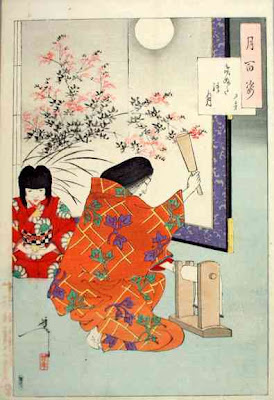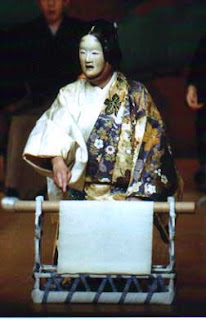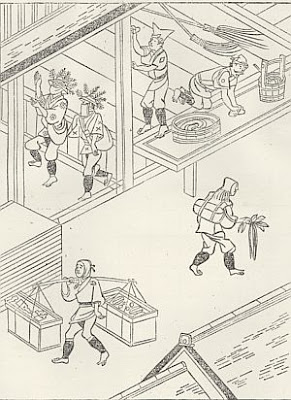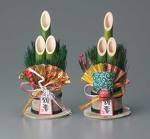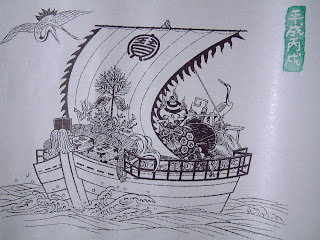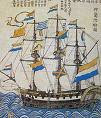:::::::::::::::::::::::::::::::::::::::::::::::::::::::::::::::::::::::::::::::::::::::::::::::::::
Song, singing (uta)
***** Location: Japan
***** Season: Non-seasonal Topic
***** Category: Humanity
*****************************
Explanation
We all sing when we feel fine or sad or any other occasion during the whole year.
But there are some special songs in Japan that are used as kigo.
Let us look at some.
song, uta 歌 , 唄
The word UTA 歌 is also used for poetry readings.
:::::::::::::::::::::::::::::::::::::::::::::::::::::::::::::::::::::::::::::::::::::::::::::::::::
SUMMER
song for planting rice paddies, taue uta
田植唄,田植歌(たうえうた)
song of the rice planting girls, saotome uta 早乙女唄(さおとめうた)
These are sacred songs that can not be sung at any other time of the year.
Rice Planting and its KIGO
song whilst spinning silk threads, itohiki uta
糸引歌(いとひきうた)
Silk (kinu), silkworm (kaiko)
:::::::::::::::::::::::::::::::::::::::::::::::::::::::::::::::::::::::::::::::::::::::::::::::::::::
AUTUMN
song for chaffing rice, momisuri uta, momizuri uta
籾摺唄(もみすりうた)
song for pounding bitter persimmons, kakitsuki uta
柿搗歌(かきつきうた)
Persimmon
:::::::::::::::::::::::::::::::::::::::::::::::::::::::::::::::::::::::::::::::::::::::::::::::::::::
WINTER
Kagura Dance Song, kagura uta 神楽歌(かぐらうた)
Kagura Dance (Japan)
:::::::::::::::::::::::::::::::::::::::::::::::::::::::::::::::::::::::::::::::::::::::::::::::::::
:::::::::::::::::::::::::::::::::::::::::::::::::::::::::::::::::::::::::::::::::::::::::::::::::::
New Year
First poetry meeting, utakai hajime
歌会始 (うたかいはじめ)
..... utakai gokai hajime 歌御会始(うたごかいはじめ)
first waka poetry meeting
..... waka gokai hajime 和歌御会始(わかごかいはじめ)
..... gokai hajime 御会始(ごかいはじめ)
:::::::::::::::::::::::::::::::::::::::::::::::::::::::::::::::::::::::::::::::::::::::::::::::::::::
A New Year Poetry Reading is a gathering of people who get together to read a collection of poems on a common theme to a wider audience. This practice was already in usage during the Nara Period, and became known through the famous volume of Japanese poetry, the Manyoshu.
An Imperial Poetry Reading is the same as the above-mentioned description, the only difference being that the poetry reading is convened by His Majesty the Emperor. As part of the annual events at the Imperial Palace, every month a Poetry Reading came to be held. Of these monthly Poetry Readings, the Imperial Poetry Reading was held as the first such party of the New Year, and was given the name Uta Gokai Hajime.
The origins of the Ceremony of the Utakai Hajime are unclear. During the mid-Kamakura period, on 15 January 1267, Emperor Kameyama convened a Poetry Reading at the Imperial Palace, which is recorded in the Gaiki Nikki as an internal ceremony. Since that time, records of the New Year's Poetry Reading can be found down through the ages. From such evidence, it can be surmised that the origins of the Ceremony of the Utakai Hajime are traceable to the mid-Kamakura period.
The Ceremony of the Utakai Hajime came to be held almost every year through the Edo period, and after the Meiji Restoration, the first Ceremony of the Utakai Hajime during the reign of Emperor Meiji was held in January 1869. Since then, among various reforms in ceremonies, the Utakai Hajime has continued to be held.
The Ceremony of the Utakai Hajime at the Imperial Palace boasts a long history and represents a ceremonial culture that has become more sophisticated with the reforms of the Meiji and post-war eras, to become a cultural event with national participation in a way that is unique in the world. Tanka poetry is said to be at the heart of all traditional culture in Japan. These tanka poems are heard and read not only in Japan, but also throughout the world, and the ceremony demonstrates their power to bind the people together with the Imperial Family through this annual ceremony at the Imperial Palace, which is something to be truly praised and lauded.

The Ceremony of the Utakai Hajime is attended by Their Majesties the Emperor and Empress, and poems recited include those chosen from submissions by the general public, poems of the selectors themselves, and poems by professional poets. Finally, the poems of the Imperial Family, Her Majesty the Empress and His Majesty the Emperor are recited. Members of the Imperial Family, including His Imperial Highness the Crown Prince are present at the Ceremony of the Utakai Hajime, and other audience members include the Minister of Education, Culture, Sports, Science and Technology, members of the Japan Academy of Art and the members of the public whose poems have been chosen.
The ceremony is performed through several participants, each with special titles: the dokuji (master of ceremonies), koji (reader of all poems), hassei (singer of poems from the first poem), and kosho (accompanying singer to the hassei for poems from the second poem).
© www.kunaicho.go.jp
:::::::::::::::::::::::::::::::::::::::::::::::::::::::::::::::::::::::::::::::::::::::::::::::::::::

First New Year Dance and Singers,
"Music of the New Year Pines"
matsu bayashi 松囃子 (まつばやし)
..... matsubayashi 松拍子(まつばやし)
o utaizome 御謡初(おうたいぞめ)
"taking off the overcoat", su ou nugi
素襖脱ぎ(すおうぬぎ)
Performed in Kyoto since olden times. Later the Shogun allowed some specially elected townspeople to enter the Edo castle and perform their New Year Song and Dance for the samurai.
Sometimes the onlookers got carried away by the merrimaking, took off their overcoat and gave it to one of the performers.
Matsubayashi singers are now also used during other ceremonies. The one in Hakata is most famous.
:::::::::::::::::::::::::::::::::::::::::::::::::::::::::::::::::::::::::::::::::::::::::::::::::::
Song to chase away the birds, tori oi uta
鳥追唄(とりおいうた)鳥追歌
A ceremony held on the "Small New Year", now January 14 or 15.
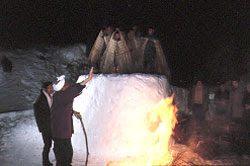
torioi (bird chasing), a ceremony to pray for a rich harvest, which takes place on January 14. In the ceremony, children eat rice cakes in special torioi huts made of snow and then parade through the city beating wooden clappers while singing traditional songs in order to chase away birds that might damage crops.
City of Tokamachi, Niigata Prefecture
© web-japan.org/
..... tori oi (tori-oi) 鳥追 "Chasing away the birds".
..... hut, tori-oi goya 鳥追小屋(とりおいごや)
..... tower, tori-oi yagura 鳥追櫓(とりおいやぐら)
..... song, tori-oi uta 鳥追唄(とりおいうた)
enjoying, tori-oi asobi 鳥追遊び(とりおいあそび)
. torioi, tori-oi, tori oi 鳥追 "chasing away the birds" ritual
- Introduction -
:::::::::::::::::::::::::::::::::::::::::::::::::::::::::::::::::::::::::::::::::::::::::::::::::::::
Balls, decorative hand balls (temari) 手まり
Japan. And the famous poet Ryokan 良寛.
Ball catching song, ball bouncing song,
temari uta 手毬歌, 手毬唄、(てまりうた)

Around 600 during the Asuka period, the kemari (蹴鞠) game was introduced from China to the court of Japan.It was a kind of kick ball for the aristocracy. From this, temari evolved.
First Kick-Ball Game (mari hajime)
kigo for the New Year
The temari thread balls are closely related to the famous priest Ryokan and his simple life. He was even called "Temari-Shoonin" 手まり上人(saint who plays with a temari ball), since he often played with these balls with the local children of his village.
WKD : Ryokan Memorial Day (Ryokan-ki) January 6.
English Temari Reference :
... www.japanesetemari.com
.........................................
Temari uta is a song that Japanese children sing to count while bouncing or catching a small ball ten times, each time saying the name of a deity or famous temple or shrine.
After counting to ten, the next verse goes a bit like this:
I believe very much in all these Buddhas and Gods,
and yet, my dear child is very ill and wont heal, my husband has to go to war and might not come back ! I cry and cough blood ... hototogisu!
Here is the Japanese version of this song:
一番初めは一の宮 ..... ichiban hajime wa Ichi no Miya
二また日光中禅寺
三また佐倉の宗五郎
四また信濃の善光寺
五つは出雲の大社(おおやしろ)
六つは村村鎮守様
七つは成田のお不動さん
八つは八幡の八幡宮
九つ高野の弘法様
十で東京泉岳寺 ..... too de Tookyoo Sengakuji
これほど信(神)願 かけたのに
浪子の病はなおらない
武夫が戦地に行くときは
白きま白きハンカチを
うちふりながらも ねえあなた
はやくかえってちょうだいね
泣いて血を吐く ほととぎす hototogisu
Regional Versions of this Song
..........................................................................

source : blog.tsurumi-u.ac.jp/murasaki
春雨にぬれつつ屋根の手毬かな
harusame ni nuretsutsu yane no temari kana
As the spring rains fall,
soaking in them, on the roof,
is a child's rag ball.
Tr. Keene
The children had been playing outside, but with the rain, they went home. One of the balls got caught on the roof and is now exposed to the rain.
The combination of a temari ball and the roof is unique for Buson.
- quote
Spring showers/in/get wet while/roof/'s/silk cloth ball/(exclamation)
(Quotes are from the 俳句大歳時記 (Haiku Dai Saijiki published by Kadokawa Shoten 1973))
The season word (kigo) is "spring showers" (harusame). It is the rain that falls for two months, now considered to be from late February through March. It is a calm quiet steady rain that traditionally in literature has a warm tenderness that is indicative of late spring. This shouldn't be confused with another seasonal word of "spring rain" (haru no ame), which is a nondescript image which can be any kind of rain that falls in spring and which doesn't have any kind of emotional significance attached to it.
The 黒冊子 (Kurosoji (くろぞうし)) is quoted as giving a calendar time frame for each, with "spring showers" (haru same) as falling in the third month while "spring rain" (haru no ame) falls from the New Year to the early part of the second month.
"Temari" (hand ball) is a traditional child's toy for girls that was homemade but by the Edo Period they were being sold in a stores. The core was either cotton, dried potato stems, a ball of harden devil tongue jelly (konyaku) or wood shavings with either clams shells or sand etc... put in. String was then wrapt around the core and finally silk threads of five colors were also wound around to produce a beautiful ball. Since the Meiji era the core has been made from imported rubber.
These hand balls were given as New Years presents to girls, who played games with them while chanting songs ("temari uta") that were specifically made for it. Girls counted the number of times they could bounce the ball, or passed it between themselves, while they sang lively and funny songs that varied from region to region. From the Edo period until the early Meiji period "temari" were usually bounced but throwing them around became the norm too after. (Now, they are just used as decorative items that are hung instead of handled or played with.)
Everyone is, I'm sure, familiar with Masaoka Shiki's "shasei" (sketches from life) theories about haiku and what a major impact that has had on Japanese haiku in the 20th century, but it also needs to be noted that this has also had a big impact on how haiku poets prior to Shiki are now read by people these days. Especially for Buson, who Shiki used as an historical example as of how sketching could be done in haiku.
When it comes to writing about this haiku, most Japanese commentators will immediately try to explain it as Buson writing about something that he has just seen or experienced. That the girls who were singing and playing with a handball had to suddenly stop because of the rain and now the ball is on the roof getting wet, or that Buson is surprised to find that the ball that has been missing is on the roof getting wet in the rain.
Since we know that "spring showers" (haru same) is in the late second and third months and that "temari" (hand ball) is something from the New Year holiday, it is impossible to think of two in the terms as presented in the reading about the rain chasing the girls from playing. And since the second reading above is telling us that Buson is out in the rain looking for something that isn't that important, then we have to consider how plausible it is to believe this haiku as being something that is unfolding in front of Buson's eyes.
The question to ask is why is the ball in the roof? The season book (saijiki) I quoted above gives us as answer, it notes that there is a senryu from Edo in the An'ei calender period (November 1972 to March 1781):
毬も突き飽きれると屋根へ投げて見る
mari mo tsuki akireru to yane e nagete miru
When I get bored of bouncing the ball, I will try to throw it on the roof
which gives a pretty clear explanation on how the "temari" Buson is writing about got up there. Buson died in 1783, so it is to hard argue that he wasn't alive when this senryu got into print.
The "cutting word" in this haiku is "kana" and it cuts the haiku at the end of "nuretsutsu" because it makes a phrase out of what follows it. It provides an exclamation of admiration of wonder that has been sparked in the speaker by what they are experiencing. But, if the object that is has peaked their interest is not in front of them, which is to say it is something that they are not directly experiencing, then it means that the speaker is wonder about or wondering if something is happening.
In the case of this haiku, it pretty obvious to believe that Buson is not on the roof looking at the ball, and while it maybe possible that he is looking up at it, the verb in the haiku implicitly states that the rain is falling, which makes it a bit harder to imagine that he his out in the rain doing this.
The verb is conjugated by "tsutsu" which translates as "while ...ing", but it also can be used to state that something is in the process of coming into a different state.
It must be getting wet in the spring showers......the colorful temari on the roof!
The New Years holiday is family time in Japan. Families gather together and spend time with each other. Spending time laughing and enjoying things with your loved ones is a special memory for everyone, especially if it involves children having a happy joyous time. The falling spring showers in the third month have made Buson remember the temari ball that got thrown on the roof, and all the laughs that happened while doing it, during the not so long ago New Years holidays. By considering what the season words add to in the haiku, we can start sketch what sentiments Buson was feeling when he wrote it.
It must be soaked
through by the warm
silent spring showers...
the colorful temari they
playfully tossed
to the roof!
The quietness of the showers reflects over the break againsy the noisy boisterous way the girls sang and played with the "temari" and makes the memory ring deeper.
I am tempted to go with "she" instead of "they" because it would bring out the tenderness more by implying that Buson was writing about his daughter. But for now, let's leave it at that.

some tamari balls:
http://twistedsifter.com/2013/12/grandma-shares-30-years-of-embroidered-temari-balls/
how to make them:
https://www.youtube.com/watch?v=6vAIrSJBSo0
temari song:
https://www.youtube.com/watch?v=JRGbCymN_TM
playing temari:
http://www.garitto.com/product/16164811
- source : James Karkoski - facebook group
. WKD : Yosa Buson 与謝蕪村 in Edo .
*****************************
Worldwide use
*****************************
Things found on the way
*****************************
HAIKU
. WKD : Kobayashi Issa 小林一茶 .
Tr. Chris Drake
今の世や見へ半分の田植唄
ima no yo ya mie hambun no taue-uta
these days
singers are performers --
rice-planting songs
wakai-shu wa mie hambun ya taue-gasa
young people
care how they look --
rice-planting hats
kasa toreba bouzu narikeri taue-uta
hat off
he's a monk --
rice-planting songs
outa ko mo hyoushi o naku ya taue-uta
on mother's back
baby cries to the beat --
rice-planting songs
oohiki mo nosa-nosa detari taue-zake
gradually
a big toad joins --
rice-planting sake
These are some of the hokku Issa wrote at rice-planting time in the 5th month (June) of 1823 and 1825. Rice-planting was an important event and was both hard work and a major village festival. The work/festival went quickly at each paddy because the work was communal. The whole village or one part of the village would gather at one paddy at a time and do the planting together, and all the paddies would be planted within a few days. The actual planting was done by women of all ages, who were called sa-otome or "rice maidens" in this role, because traditionally they were believed to have more shamanic power than men, though men sometimes helped out if need be. According to many scholars, in the ancient period village women actually went into seclusion and did austerities, sang sacred songs, and focused their spiritual power for several days before planting rice, and the planting songs sung at Shinto shrines even today retain a strong shamanic element, with the mountain god coming down and becoming the field god through the welcoming power of the women planters and their songs.
The songs and other rice-planting rituals in villages in Issa's time probably retained some of this welcoming-ceremony character, although many types of planting songs were sung. The festival began with songs sung while bringing young rice shoots to the fields early in the morning and continued with other morning songs as the women began to plant the shoots in the flooded paddy. Many of the songs were humorous and even amorous, perhaps reflecting the ancient pattern in which the woman shaman and male god were lovers. In any case, love songs were believed to bring fertility to the paddy.
As for the songs, morning planting songs were often about a woman saying goodbye to her visiting lover in the morning, while other songs praised the god of the field. Noon songs praised the people who brought food presented to the god -- and to those working in and near the paddy. Afternoon songs were usually long, with a lot of repetition, and could be prayer-like, about how well the rice will soon be growing, or even love songs. Late in the afternoon the women would sing farewell songs that were also farewells to the god of the field for the day. Meanwhile men also did a lot of support work, and male musicians played one or more drums, sometimes together with flutes, gongs, and other instruments.
Meter was often irregular, although in some areas of Japan stanzas had a fixed meter, such as the popular 7-7-7-5 syllable stanza, and improvisation was generally permitted. The songs were performed according to a call and response structure, with the drummer calling out a stanza the planters singing a response or reply, often humorous. This dialogical structure, which can be found even in the earliest mythic texts, is believed to have been an important element in the evolution of linked song into linked verse -- renga and then haikai. And in addition to influencing poetry, the ceremonies, dances, and skits at shrine rice-planting festivals also constituted one of the main traditions out of which No and other forms of Japanese drama and dancing emerged.
Basho noticed the relationship with haikai when he made his trip to the north and saw musicians and women planters engaging in song dialogs in the rice fields in the rural Oku area of Honshu, where he wrote:
fuuryuu no hajime ya oku no taue-uta
poetry's source --
rice-planting songs
in far fields
Basho seems to mean that dialogical rice-planting songs are not only the most basic origin of renga and renku but also a continuing, timeless source of haikai that he will draw on as he travels through the north country. .
In Issa's first hokku he remarks, apparently humorously, that the women in bright colors singing in the paddies (and no doubt the men musicians and helpers) have become more interested in the performance itself than they used to be. Issa, now sixty, is presumably comparing the singers with those he remembers from his childhood. Apparently people now wear more stylish robes and sing with more consciousness of technique and personal style than they did several decades before. It's possible this change is at least partly due to the large numbers of poor farmers from the area who, like Issa, went to Edo and later returned with new ideas and styles. It's also possible Issa doesn't realize that the women in colorful robes who sing their songs so dramatically are thereby trying to please and attract the mountain god and invite him down to their field. In any case, the hokku seems to be an observation rather than a criticism.
The second hokku seems to be about both young men and women, who are more conscious of fashion and personal attractiveness than they used to be. People at a rice planting festival wore several types of wide rush or straw hats, often decorated, and both men and women now use even their hats to express themselves, perhaps since their faces under the large hats are hard to see. In the third hokku, one man who has been helping out takes off his wide hat and turns out to be a Buddhist monk. He seems to enjoy taking part in the festival, singing about ribald situations and Shinto gods, even though he isn't a Shinto priest.
This could be satire, but I take Issa to be impressed by the monk's ordinary humanity and his willingness to help out. In the fourth hokku, a woman plants with her young child strapped or wrapped against her back, the most common way of carrying young children in Issa's time. The child is crying, but its cries follow the beat of the drum and the rhythm of the songs its mother is singing. In the fifth hokku, a large toad shows up at the festival, and it seems to like the sake which is being served after the planting has finished. Its cautious movements are slow and unobtrusive, and by the time people notice, it's right below the flowing sake.
All five of these hokku (and several others written at the same time) have identical or similar last lines. At first glance this seems monotonous, but Issa may be trying to reproduce a certain aspect of rice-planting songs for the reader by doing this. Although a drummer and the planters would exchange hundreds of stanzas during the day, many songs had recurring refrains. One common pattern, suggesting a connection with early renga and renku, was to repeat the last line of the call stanza as the first line of the reply stanza. By repeating the same third line, Issa's hokku give readers a physical sense of planting-song refrains.

. . . CLICK here for Photos !
Chris Drake
Rice Planting and its KIGO
:::::::::::::::::::::::::::::::::::::::::::::::::::::::::::::::::::::::::::::::::::::::::::::::::::::::
手毬歌かなしきことをうつくしく
temari uta kanashiki koto o utsukushiku
ball bouncing song -
such a sad thing
said so beautifully
Takahama Kyoshi
Tr. Gabi Greve
:::::::::::::::::::::::::::::::::::::::::::::::::::::::::::::::::::::::::::::::::::::::::::::::::::::
鳴く猫に赤ン目をして手まり哉
naku neko ni akambe o shite temari kana
making a face
at the whining cat...
bouncing her ball
涼しさよ手まり程なる雲の峰
suzushisa yo temari hodo naru kumo no mine
summer cool--
the puffy clouds
like handballs
寝ころぶや手まり程でも春の山
ne-korobu ya temari hodo demo haru no yama
lying down
they look like handballs...
spring mountains
Kobayashi Issa
Tr. David Lanoue
:::::::::::::::::::::::::::::::::::::::::::::::::::::::::::::::::::::::::::::::::::::::::::::::::::::
桃の咲く寺の境内手まり唄
momo no saku tera no keidai temari uta
in a temple garden
with peach blossoms -
ball bouncing son
© author anonymous / www.gendaihaiku.gr.jp
*****************************
Related words
***** Saijiki of Buddhist, Shinto and other Ceremonies
and Events of Japan and related kigo
:::::::::::::::::::::::::::::::::::::::::::::::::::::::::::::::::::::::::::::::::::::::::::::::::::::
[ . BACK to DARUMA MUSEUM TOP . ]
[ . BACK to WORLDKIGO . TOP . ]
:::::::::::::::::::::::::::::::::::::::::::::::::::::::::::::::::::::::::::::::::::::::::::::::::::::


